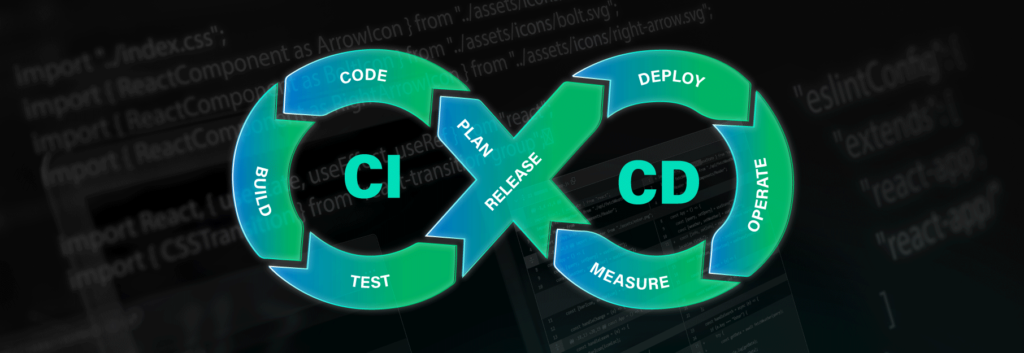Benefits of continuous integration and continuous deployment
Continuous integration (CI) and continuous deployment (CD) are essential in the processes of a software factory because they ensure a Fast, reliable and high quality delivery of computer products.
They allow errors to be detected and corrected early, through test automation and frequent code integration, which improves collaboration and allows the code base to always be functional.
They also facilitate the automatic deployment of new versions of software in any environment, ensuring that updates reach users quickly and with less risk by implementing incremental changes.
These practices optimize the efficiency and productivity of the development team. They also improve customer satisfaction and allow companies to respond quickly to technological and market changes and remain competitive.
In this article we analyze the impact of continuous integration and deployment and explain how the CI/CD methodology is implemented.
What is continuous integration and continuous deployment (CI/CD)?
Continuous integration and continuous deployment (CI/CD) are fundamental practices in modern software development.
They are looking for improve process quality and efficiency, through automated integration and delivery of code changes.
CI/CD is a method designed to automate development processes and streamline their integration, delivery and deploymentHow? By helping to build efficient pipelines that integrate individual developers' code editing into a common process chain.
As a result, updates can be tested and validated in code packages, allowing software versions to be kept up to date.
Let's look at each of these two practices in detail.
Continuous Integration (CI)
It is a software development practice in which Developers integrate their work frequently, at least once a day.
Each integration is verified by an automated build (including tests).
Its goal is to detect errors quickly and locate integration problems as soon as possible.
The process includes automating the project build and running unit tests whenever there is a change in the code. This ensures that the code, in the main repository, always be functional and free of major errors.
Continuous Deployment (CD)
It consists of a practice where every change that passes the automated tests is automatically deployed to a production environment.
The term is also sometimes used to refer to the process of continuously delivering software to pre-production environments for further testing and review.
Its objective is to ensure that the software can be released into production at any time, quickly and safely.
It involves automating the deployment of software, from version control to delivery into the production environment. It may also include running additional tests in staging environments, and continuous monitoring of the deployed software.

Impact of Continuous Integration and Continuous Deployment (CI/CD)
In a constantly evolving landscape of software development, DevOps and continuous integration and deployment (CI/CD) are synonymous with efficiency, collaboration and accelerated delivery.
- DevOps It fosters collaboration between development and operations, transcends traditional silos, and, together with automation, addresses challenges associated with manual processes. As a result, it generates faster cycles, fewer errors, and better software quality.
- The continuous integration (CI) ensures seamless code integration, making it easier to detect problems early.
- The continuous deployment (CD) Automate the delivery process and streamline the process from development to deployment, for greater reliability and responsiveness.
Continuous integration and continuous deployment (CI/CD) are undoubtedly coming profoundly transformed software development and offering multiple positive impacts on various aspects of the process.
Its main impacts include the following:
Improving software quality
Integrating automated testing into your CI/CD pipeline ensures that your code goes through rigorous checks, allowing you to detect and fix bugs before they reach production.
Additionally, automation of build and deployment processes ensures that each version of the software is built and deployed consistently and reliably.
Faster delivery speed
CI/CD enables frequent release of new features, bug fixes, and improvements. This speeds up the development cycle and provides the ability to respond quickly to market needs.
In fact, shorter feedback cycles and automated deployments significantly reduce the time required to go to production.
Risk reduction
Changes are rolled out in small, incremental modifications, making it easier to identify and correct specific problems without affecting large parts of the system.
In case something goes wrong during deployment, automated rollback mechanisms allow you to quickly revert to the previous stable version.
Improved team collaboration
CI/CD pipelines provide continuous visibility into project status, improving communication and collaboration between development, operations, and quality teams.
These practices foster a DevOps culture, where teams work together to continuously improve processes and software delivery.
Efficiency and time saving
Manual, repetitive tasks such as building, testing, and deploying are automated, freeing developers to focus on higher-value activities.
In this regard, it is important to highlight that this automation minimizes the possibility of human errors in the construction and deployment process.
Fast feedback and continuous improvement
Developers receive immediate feedback on the status of their code and test results.
While monitoring tools built into the pipeline provide real-time data on software performance and stability, informing future improvements.

Flexibility and scalability
CI/CD practices allow rapid adaptation to changes in project requirements or new technologies, facilitating continuous software evolution.
In parallel, automated processes can easily scale to handle larger, more complex projects, without the need to increase teams.
Enhanced security
Automating security testing and code reviews ensures that vulnerabilities are detected and fixed before reaching production. CI/CD also facilitates the implementation of security policies and regulations throughout the software lifecycle.
Examples of impact in practical cases
As we mentioned before, CI/CD has a profound and positive impact on software development.
Improve quality, speed, efficiency and collaboration; reduce risks and increase adaptability and scalability.
Technology-based companies, such as large marketplaces and social media platforms, among others, They use CI/CD practices to release new functionality on a regular basis., maintaining a rapid and continuous innovation cycle.
Startups are also adopting CI/CD to accelerate time to market, allowing them to Rapidly iterate on their products and adapt to user needs.
In open source software projects, these practices ensure that contributions from developers around the world are efficiently integrated and tested.
How is continuous integration and continuous deployment (CI/CD) implemented?
Implementing the continuous integration and deployment (CI/CD) methodology involves considering a series of stages and practices.
It begins by analyzing the needs that must be covered, and from there the work is planned, considering the frequency of deployments and test environments, among other issues.
The steps for Continuous Integration (CI) are as follows:
Code repository
Use a version control system to manage source code and allow developers to work in a shared repository.
Build Automation
Set up a CI server to automatically build the project every time a commit is made.
Automated testing
- Unitary, to individually validate each software component.
- Integration, to ensure that the different components of the system work properly together.
- Acceptance or system testing, to verify the behavior of the system as a whole, often based on user requirements.
Code review
Through pull requests or merge requests, before merging changes into the main branch. Static code analysis tools are used to assess code quality and detect potential problems.
Regarding the Continuous Deployment (CD) process, which allows new software versions to be released quickly and reliably, the following steps are typically followed:
- Extend the CI pipeline to include stages and deployment environments (e.g. development, testing, production).
- Automate code delivery to different test and production environments, ensuring that they are reproducible and reversible.
- Carry out testing in pre-production environments, to ensure that the software works correctly before going into production. Also, add automated security, load and performance tests to the CI/CD pipelines, to detect problems at an early stage.
One aspect to keep in mind is to keep the CI/CD flexible and adaptable to changes in the project's technologies, tools or practices.
Throughout the process it is important Implement DevOps practices, such as fostering collaboration between development, operations and quality teams, and promoting a culture of continuous improvement.
To achieve these objectives, it is essential be based on the following principles:
- Maintain a single code repository.
- Automate compilation.
- Perform build self-test.
- Commit to the main branch every day.
- Every commit (to the main branch) should be compiled.
- Every bug fix commit should come with a test case.
- Keep the build in the shortest possible time.
- Perform testing on a clone of the production environment.

Good practices in integration processes and continuous deployment
Best practices in the continuous integration phase include:
- Configure CI pipelines to run automatically when changes are made to the version control repository.
- Set up automatic notifications and reports to inform developers about the status of builds and tests.
- The Continuous integration must occur frequently enough so that there is no window between commit and build, and no bugs arise without developers noticing and fixing them immediately. Normal practice is to trigger these builds for every commit to a repository, rather than a periodically scheduled build.
- Have a version control system that supports atomic commits. That is, all of a developer's changes can be viewed as a single commit operation.
14 benefits of the CI/CD methodology
Implementing continuous integration and continuous deployment (CI/CD) offers numerous benefits that significantly improve software development.
Among them:
1) Early error detection and resolutionBy integrating and testing code frequently, errors are detected and corrected quickly, reducing the time and costs associated with troubleshooting.
2) Fast and frequent delivery: CI/CD enables continuous delivery of new features and bug fixes to production, with improved development velocity and faster response to market and customer needs.
3) Improving code quality: Automated testing and continuous integration ensure that code always goes through a series of checks before being merged, maintaining high quality standards.
4) Risk reduction: Frequent, small deployments are less risky than large ones, as it is easier to identify and correct problems in smaller changes.
5) Quick feedback: Developers receive immediate feedback on the status of code and tests, making it easier to fix bugs and continuously improve code.
6) Greater collaboration and communication: CI/CD fosters collaboration between development, operations, and quality teams as everyone is involved in the continuous integration and deployment process.
7) Automation of the deployment process: Reduces the time and manual effort required to release new software versions, allowing developers to focus on more important and strategic tasks.
8) Consistency in the development environment: reducing the problems that arise from differences between these environments.
9) Improved configuration management: ensuring that the applications are deployed consistently across all environments.
10) Ease of scalability: which provides a solid foundation for handling larger and more complex projects.
11) Optimized security: Automated security testing and quality checks are integrated into the CI/CD pipeline. This helps identify and mitigate vulnerabilities, before code reaches production.
12) Greater customer satisfaction: based on the ability to deliver new features and enhancements quickly and reliably.
13) Accelerate time to marketBy automating and optimizing software development, testing and deployment cycles, the time required to deliver new functionality is significantly reduced and improved from development to the end user.

Conclusion
DevOps and continuous integration and continuous deployment (CI/CD) are Essential practices in modern software development, which they have revolutionized by promoting agility, collaboration and efficiency.
For the data scientist, DevOps addresses challenges through a unified approach, breaking down silos between development and operations.
In this sense, the CI/CD process automates key aspects of software delivery, enabling faster time to market, higher quality, and overall efficiency.
As organizations adopt these practices, successful implementation requires a cultural shift, investment in tools, and commitment to continuous improvement.
Learn how we can contribute to accelerate the development of new products and services for your organization.

